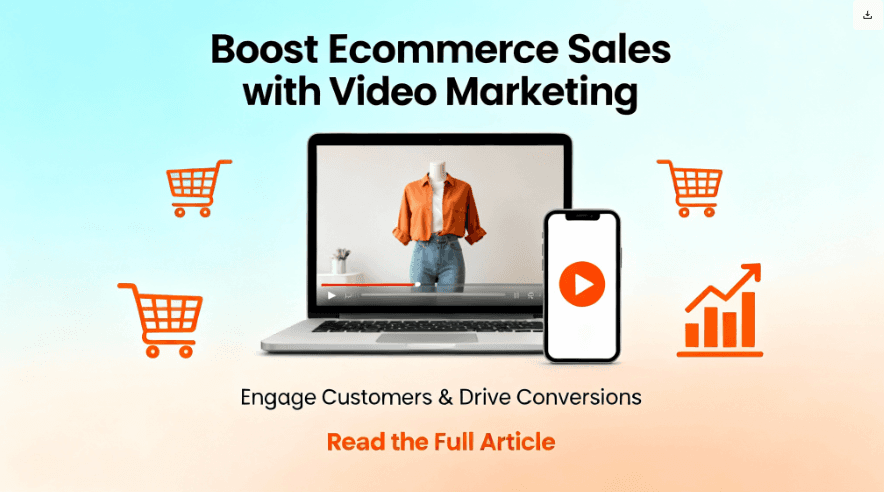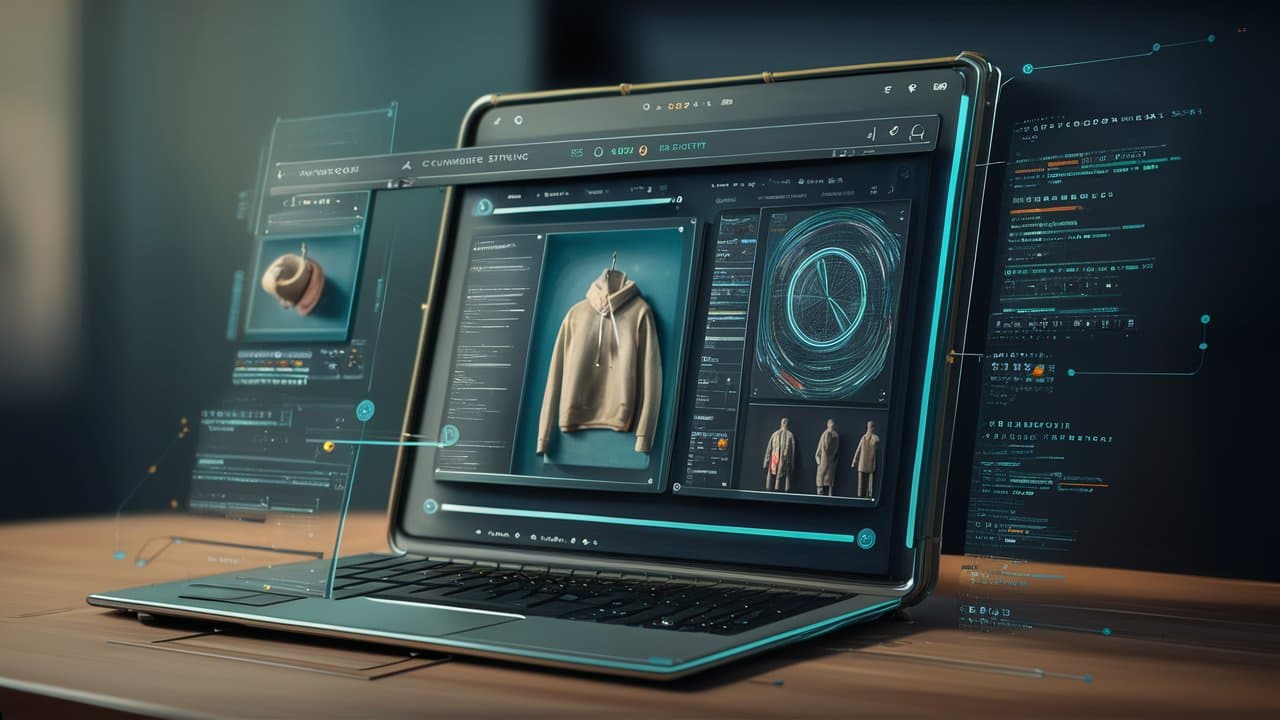Using Video for Ecommerce Products & Upsells: The Technical Playbook

Use videos in e-commerce to generate effective upsells. Place short videos on product pages to showcase premium features or demonstrate complementary products. You can also embed these videos in the shopping cart or during checkout. This visual approach encourages customers to upgrade or add more items, directly increasing average order value.
Using video for product explainers or to upsell in e-commerce isn’t just about putting a nice-looking clip on a product page. It’s a technical strategy. When you embed a video, you’re not just showing off premium features; you’re intervening at a critical decision point in the user journey, usually on a product page, in the cart, or even at checkout. The goal is to visually articulate why a customer should spend more, increasing your average order value (AOV) right then and there.
The Technical Framework: Why Upsell Videos Actually Work
Before you even think about hitting record, you have to grasp the technical and psychological underpinnings. An upsell video isn’t just another marketing asset. It’s a precision tool engineered to nudge a customer towards a higher-value purchase at the exact moment they’re most receptive. Getting this right hinges on understanding its function, why it persuades, and how to measure if it’s even working.
Defining the Upsell Video: It’s All About the Delta
Fundamentally, an upsell video is a short, strategically placed asset that demonstrates the superior value of something more expensive. This could be a premium version of a product or a complementary add-on. Its job isn’t to re-explain the base product; a regular demo does that. Instead, it focuses exclusively on the delta, the tangible, incremental benefit a customer gets for spending more. Its real function is to resolve hesitation by justifying the price jump.
The technical implementation is key here. We’re talking about triggering these videos at specific moments in the UI. Maybe it’s a modal pop-up when a user adds the “basic” version to their cart, or a thumbnail that appears on the product page only after they’ve selected the lower-tier option. The point is to deliver the right information at the precise moment of decision.
The Cognitive Shortcut: Why Video Works on the Brain
The effectiveness of this is rooted in some pretty basic cognitive psychology. Humans are visual creatures; we process images and motion exponentially faster than text. A video can transmit complex features, emotional context, and tangible benefits in seconds… a task that would otherwise require paragraphs of dense copy that, let’s be honest, no one reads.
This is more than just engagement. It’s about building trust through transparency. Seeing a product in action, especially seeing how the premium version solves a problem better than the standard one, removes the ambiguity and risk inherent in online shopping. Suddenly, the upsell isn’t a pushy sales tactic; it’s a helpful recommendation. This shift in perception is critical for the customer experience.
Core Metrics: How to Know if You’re Wasting Your Time
To validate this strategy, you have to track the right KPIs. And I don’t mean vanity metrics like view count. Measuring ROI requires a granular look at the entire funnel.
Here’s what you should actually be watching:
- Upsell Adoption Rate: This is the big one. What percentage of eligible transactions actually included the upsell after a video view? This tells you if the video itself is doing the convincing.
- AOV Lift: Track the average order value for user sessions that included a video view versus those that didn’t. This is your direct line to revenue impact.
- Conversion Rate Lift (by viewer): This is a useful, but sometimes misleading metric. Initially, you’ll want to measure the conversion rate of shoppers who watch the video versus those who don’t. But be careful, engaged shoppers are more likely to watch videos and convert anyway. A better approach is to A/B test the page with and without the video to get a true measure of its impact. Critical distinction.
- Video Engagement Graph: Most professional video hosts provide this. It shows you exactly where viewers drop off. If everyone is leaving at the 10-second mark, you know your intro is failing.
Strategic Video Types for Ecommerce Upsells
Not all videos are created equal. Choosing the right format for your product and audience is half the battle. Each of these has a different psychological trigger.
The Comparison Video: The Most Direct Approach
This is probably the most powerful format for a direct product upgrade. You put the standard and premium versions side-by-side and let the results speak for themselves. The whole point is to make the concept of “premium value” tangible. A software company could use a split-screen to show the 5 clicks it takes to do something in the premium plan versus the 25 manual steps in the basic plan. It’s undeniable proof.
The Premium Feature Showcase: Isolating the “Hero” Feature
When your upsell is based on a few killer features, this is your go-to. You isolate that one “hero” feature and do a deep dive. Forget the spec sheet, show it in action. Think of a high-end kitchen knife. A video can show its superior edge retention by slicing through a tomato after weeks of use, while the standard knife struggles. That’s a visual that justifies price.
The “How-It-Works” Upgrade: Demystifying Complexity
Perfect for tech products or anything where the upgrade offers a more efficient process. This isn’t about a side-by-side comparison but about educating the customer on the experience they’re buying. For example, a smart home company could show how effortlessly a user can create an automation routine with the premium hub, a feature totally absent from the base model. This format lowers the barrier to entry for less tech-savvy users.
The Social Proof Video (UGC & Testimonials): Borrowing Credibility
Leveraging user-generated content is a power move. An upsell video that stitches together clips of real customers explaining why they chose the premium version is incredibly persuasive. It provides authentic social proof that no polished, brand-generated content can ever replicate. Hearing a peer rave about the durability of the upgraded luggage is far more convincing than hearing it from the brand itself.
The Accessory/Cross-Sell Video: Expanding the Definition of “Upsell”
Remember, upselling isn’t just about a more expensive version of the same thing. It can be about selling a key accessory. A well-made video can demonstrate how an accessory transforms the core product from “good” to “amazing.” A camera retailer showing what a specific portrait lens can do, presented right when someone adds a camera body to their cart, makes the value proposition immediate and compelling.
The Post-Purchase Instructional Video: Planting Seeds for the Next Upsell
The relationship doesn’t end at checkout. Sending a “how-to” video for the product they just bought provides immense value and keeps your brand top of mind. But here’s the strategic play: within that tutorial for the standard product, you can seamlessly mention how a specific task would be faster or easier with a premium accessory. This is about creating future demand.
Technically, this means integrating with your email automation platform. You can trigger these videos to be sent a few days post-purchase and house them in a customer-only resource hub. By tracking who watches, you can build segments for highly targeted follow-up offers.
The Nuts and Bolts: A Step-by-Step Production Workflow
Creating a video that converts requires a structured process. This isn’t just about art; it’s about engineering a persuasive asset.
Step 1: Pre-Production (Where Most Videos Fail)
Rushing this stage is the number one reason upsell videos flop.
- Define a Single Goal: First, figure out exactly who you’re talking to and what you want them to do. Is the goal to upgrade from “Basic” to “Pro”? Add a warranty? Every decision from here on out must serve that one, specific goal.
- Script and Storyboard: Your script needs a clear problem-solution-benefit arc. Keep it concise; aim for a final video length of 60-90 seconds, max. Once the script is locked, create a storyboard. This is just a sequence of sketches that maps out each scene. It forces you to align your visuals with your words before you’ve spent any money on production. It’s your blueprint.
Step 2: Production and Asset Creation
This is where you create your raw materials. Technical quality reflects directly on your brand.
- Gear Check: For live-action, you need decent gear. A DSLR or mirrorless camera shooting in 1080p is the bare minimum; 4K is better for future-proofing. But lighting is even more important. A simple three-point lighting setup (key, fill, and back light) is non-negotiable. And for the love of all that is holy, use an external microphone. Bad audio will kill your video faster than anything else. (This is a classic rookie mistake, by the way—spending a fortune on a 4K camera and then using the built-in mic).
- Software: For screen recordings, tools like Camtasia or ScreenFlow are solid. For more advanced 2D motion graphics, you’re looking at Adobe After Effects. The key is to match the tool to your team’s skill set.
Step 3: Post-Production and Optimization
This is where the story comes together. It’s a mix of art and technical precision.
- Editing for Attention: Keep the pace snappy. Use cuts, text overlays, and dynamic transitions to maintain viewer momentum.
- The Call-to-Action (CTA): Your video has to tell people what to do next. This can be a simple text overlay at the end, but what’s interesting here is that more advanced platforms like Wistia or Vimeo allow for interactive, clickable CTAs inside the video player itself. This can dramatically increase click-through rates.
- Compression is Crucial: A massive video file will tank your page load speed, which hurts both UX and SEO. You have to compress your video. The goal is to find the sweet spot between file size and quality. In practice, this means using a modern codec like H.264 (or H.265 if you’re feeling adventurous, though browser support can be a gotcha) and exporting in an MP4 container for max compatibility.
Step 4: Deployment and Strategic Placement
Where you put the video is just as important as what’s in it.
- On the Product Page: A common implementation is showing a “See the Pro in Action” link that opens the video in a modal lightbox. This keeps the user on the page.
- In-Cart or Checkout: This is a high-intent moment. A subtle, non-intrusive embedded player can appear after someone adds the standard item. The messaging is key: “For just $20 more, see how the Premium model does X.”
Making it Work: Data, Testing, and Optimization
Launching the video is just the beginning. To get real ROI, you have to analyze and iterate.
A/B Testing: Don’t Guess, Know
Never assume your first attempt is the best. A/B testing is how you optimize. But a word of warning: A/B testing video can be resource-intensive. Start small.
- Test Thumbnails: A person’s face vs. the product. Easy to do, and it can have a huge impact on play rate.
- Test Video Length: A 90-second deep dive vs. a 45-second punchy version. See how it affects completion and conversion.
- Test Placement: Product page vs. in-cart pop-up. Find out where it has the most leverage.
Using Analytics to Get Smarter
Your video host’s analytics (Wistia, Vimeo Pro, etc.) and your website analytics (Google Analytics) are a goldmine. Use the engagement graphs to see where people are dropping off. If there’s a huge dip at the 15-second mark, you need to re-edit that section. By integrating video analytics with your e-commerce platform, you can build powerful segments. For instance, you can create an audience of users who watched 75% of an upsell video but didn’t convert, and then hit them with a targeted retargeting ad.
Real-World Examples
Let’s make this less abstract.
- SaaS Company: A project management tool wants to move users from “Free” to “Business.” They embed a screen-recording video in the free user’s dashboard that shows how the premium automation feature can perform a tedious task automatically in under 60 seconds. The CTA is right below the video. It works because it quantifies the benefit (“save 10 hours a week”) and proves how easy it is to achieve.
- Electronics Retailer: An online store sells a standard drone and a “Pro” model. On the standard drone’s page, they have a video titled “Standard vs. Pro: See the Difference.” It uses split-screen footage to show the Pro’s superior low-light camera performance. It’s a classic “show, don’t tell” that provides undeniable proof of value. No amount of text can do that.
- Apparel Brand: A clothing brand sells a premium t-shirt made from a technical, wrinkle-resistant fabric. Their video shows a person pulling the shirt out of a packed suitcase completely wrinkle-free, then cuts to user-generated clips of customers praising its comfort. It sells a lifestyle and builds trust at the same time.
Final Thoughts: The Future is Visual
Using video for upsells isn’t a trend; it’s a fundamental shift in how we communicate value online. As tech evolves with things like AR try-ons and interactive video, the opportunities will only get bigger. The brands that win will be the ones that master the art and science of visual commerce today, using video not just to display products, but to intelligently guide customers toward better decisions.
Commonly Asked Questions
Below you can see common questions we get asked.
How do upsell videos actually build trust and not just come off as a sales pitch?
Trust comes from transparency. When a video shows the tangible benefit of an upgrade, like a side-by-side comparison where one product clearly outperforms the other, it feels less like a pitch and more like a helpful demonstration. It’s providing evidence, not just making claims. This visual proof reduces the perceived risk for the shopper, giving them the confidence to spend more.
What’s the best way to place these videos so they don’t annoy or distract shoppers?
Context is everything. You want to be helpful, not intrusive. Placing the video as an optional-to-watch thumbnail on a product page or as a subtle offer after an item is added to the cart is usually the best approach. Avoid auto-playing videos with sound or aggressive pop-ups that interrupt the shopping flow. The goal is to offer valuable information to those who are interested, not force it on everyone.
What’s one key feature an upsell video absolutely must show to be effective?
It has to visually demonstrate the solution to a known pain point. Don’t just show a feature; show how that feature makes the customer’s life easier. For software, that could be automating a tedious task. For a physical product, it could be showing its superior durability under stress. You need to connect the premium feature directly to a tangible, real-world benefit that justifies the extra cost.
Ready to Boost Your Shopify Store?
Increase revenue with video upsells and dominate search rankings with AI-powered SEO.
Related Articles

Shopify Store Doubles Traffic & Increases Revenue Using Optizen
Below is a recent update on a site using Optizen, and the impact a simple change and a simple Optizen feature made to this Shopify store – doubling traffic and increasing revenue. The process is so simple, and still so powerful today.

How To Use A Custom GPT To Produce Ecommerce Product Descriptions & SEO Meta Based On Top Competitors
Following on from our articles and tutorials on using GPT and AI tools to create and publish quality blog content, in this article we will work through step but step how we also do the same for ecommerce product pages and SEO meta. Check out the other mentioned articles: 1. The Goal: Generate / Update […]

Creating Content For Blog Posts Using AI – SurferSEO + Custom GPTs For 70+ Content Scores
As like many making a living online, in the last 12 months we’ve dived deep into AI, and vigorously researched, tested and executed AI strategies in all areas on our businesses. Some have failed, some were underwhelming, and others have performed well. Some very well. What we’ve experienced with using AI, is that there is […]